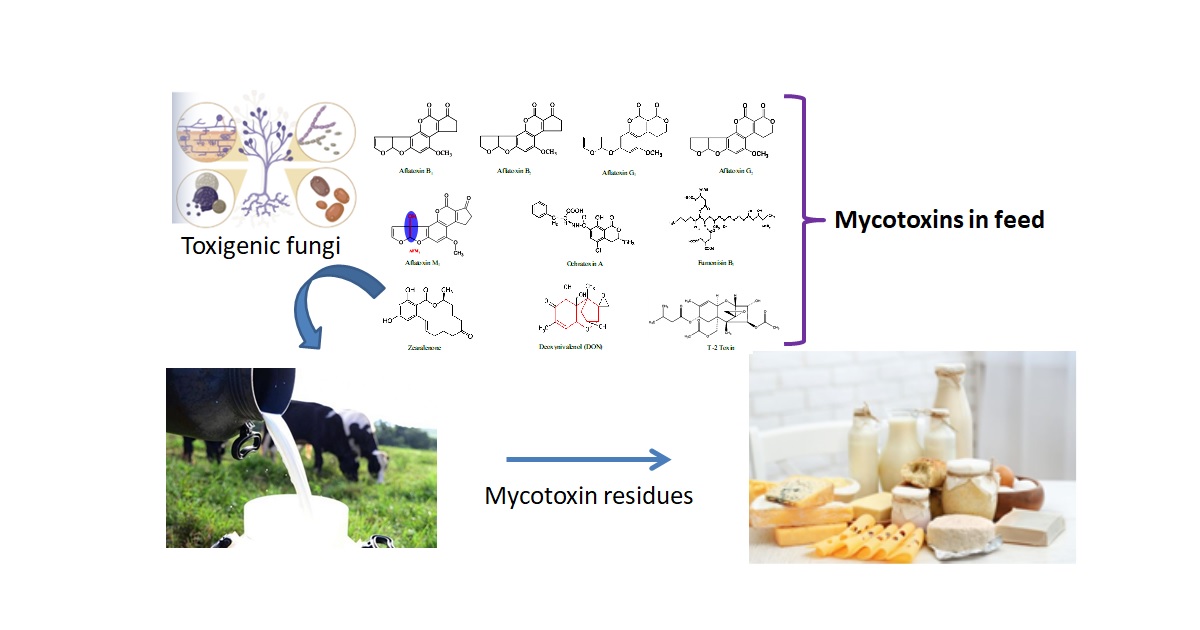Mycotoxins in the Dairy Industry
A special issue of Dairy (ISSN 2624-862X). This special issue belongs to the section "Metabolomics and Foodomics".
Deadline for manuscript submissions: closed (20 July 2023) | Viewed by 7386

Special Issue Editors
Interests: quantification and removal of mycotoxins; aflatoxin decontamination in food commodities; removal/degradation of different toxins in food commodities
Special Issues, Collections and Topics in MDPI journals
Interests: mycotoxins; dairy products; prevention/removal/degradation of different mycotoxins in food commodities; ruminant nutrition; feed additives
Special Issues, Collections and Topics in MDPI journals
Special Issue Information
Dear Colleagues,
Mycotoxins are toxic compounds produced as secondary metabolites by certain groups of fungi during their development, especially in cereals, which can produce several toxic effects in animals and humans. The most important fungi genera that produce mycotoxins are Aspergillus, Penicillium, and Fusarium, and the main classes of mycotoxins produced by these genera are the aflatoxins (AF), ochratoxin A (OTA), fumonisins (FB), deoxynivalenol (DON), and zearalenone (ZEN). When dairy animals ingest these toxins, in addition to their toxic effects, their metabolites or unmetabolized compounds may be transferred to their milk. In particular, dairy cows may shed mycotoxins and their respective biotransformation products in milk and milk products, leading to an additional exposure route for dietary mycotoxins in humans. Thus, this Special Issue addresses the challenge of mycotoxin contamination in the dairy industry, and welcomes studies that: report mycotoxin occurrence data in milk and dairy products; perform toxicity studies in dairy animals exposed to dietary mycotoxins; clarify biotransformation patterns of mycotoxins in lactating animals and their potential contribution for human exposure through the consumption of dairy products; and describe new analytical methodologies to determine mycotoxins in dairy food matrices. Critical reviews on the impacts of mycotoxins on dairy production systems and regulatory issues are also welcome.
Prof. Dr. Carlos Augusto Fernandes De Oliveira
Dr. Carlos Humberto Corassin
Guest Editors
Manuscript Submission Information
Manuscripts should be submitted online at www.mdpi.com by registering and logging in to this website. Once you are registered, click here to go to the submission form. Manuscripts can be submitted until the deadline. All submissions that pass pre-check are peer-reviewed. Accepted papers will be published continuously in the journal (as soon as accepted) and will be listed together on the special issue website. Research articles, review articles as well as short communications are invited. For planned papers, a title and short abstract (about 100 words) can be sent to the Editorial Office for announcement on this website.
Submitted manuscripts should not have been published previously, nor be under consideration for publication elsewhere (except conference proceedings papers). All manuscripts are thoroughly refereed through a single-blind peer-review process. A guide for authors and other relevant information for submission of manuscripts is available on the Instructions for Authors page. Dairy is an international peer-reviewed open access quarterly journal published by MDPI.
Please visit the Instructions for Authors page before submitting a manuscript. The Article Processing Charge (APC) for publication in this open access journal is 1200 CHF (Swiss Francs). Submitted papers should be well formatted and use good English. Authors may use MDPI's English editing service prior to publication or during author revisions.
Keywords
- Aflatoxins
- Ochratoxin A
- Zearalenone
- Milk quality
- Dairy products
- Occurrence
- Decontamination
- Dairy animals
- Toxicity






